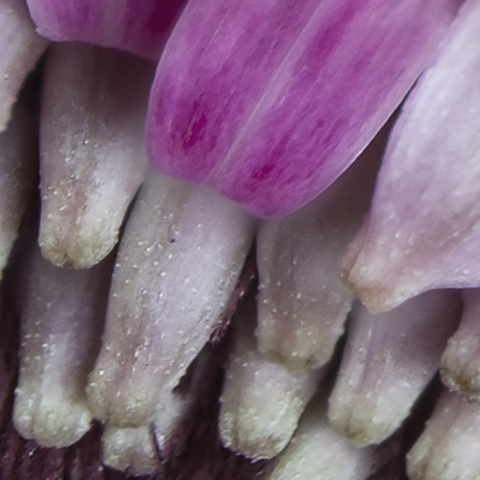
I know it may not seem like it at this scale, but the full size version of this photograph is 80 megapixels. In order to create the final photograph, I had to use a combination of macro photography, photo stitching, and focus stacking. The goal here was to give myself a technical challenge, using multiple techniques to create a single photograph.
The macro photography part of this photograph should be fairly obvious. The photo is an extreme close-up of a flower. The flower itself was only a few inches wide, so the final result is much larger than life-size. If printed at 240 pixels per inch (PPI), the overall print would be approximately 48 by 29 inches. A 100% crop of a 2 by 2 inch square is also provided to help give a sense of scale. That crop is just a 2 inch section of an overall print that would be 4 feet wide.
Additionally, this photograph is actually multiple photographs stitched together. Stitching individual photographs together to form larger panoramas is a fairly common technique in landscape photography. Most modern cell phones have a panorama mode in their respective camera applications as well. However, in this case, the photograph is a close-up shot of a flower using a macro lens, which presents a fairly difficult situation for stitching together images.
In particular, minimizing parallax is a big problem in situations like this one. While minimizing parallax is important when taking panoramas in general, it is vitally important when the subject of the photograph is so close to the lens. Even a slight angle change can lead elements in the scene moving relative to one another. When stitching together the final photograph during post processing, those relative movements can cause all kinds of issues. Care must be taken when taking the initial photographs.
To help reduce parallax, a panoramic tripod head (or pano head for short) is used. Pano heads mount to the top of a tripod and are specifically designed for creating panoramas. Their design allows for the camera to rotate around the focal point for the lens. By doing this, there is no parallax between images as the camera rotates in space between individual exposures.
Because the camera was so close to the flower and a macro lens was being used, the depth of field was very small. This is yet another challenge when taking a photograph like this one. To correct for this, a technique called focus stacking was used to bring more of the flower into focus. This photo was actually one of the first times that I tried to use focus stacking.
Focus stacking is a technique used to combine multiple photographs, each with a sightly different focus. It is analogous to bracketing, where each individual photograph has a slightly exposure, and then those different exposures are combined so the final photo covers a wider range of light. In focus stacking, the thing being varied is the focus. During post processing, those images are then combined to bring more of the overall scene into focus than what would have been possible only using a single photograph. The sharpest portions of each photo are selected and used in the final photograph.